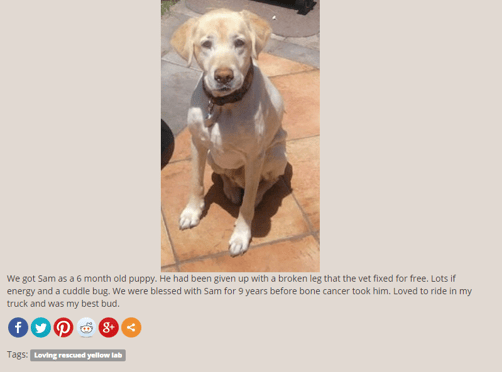How Blogging Can Boost Your Customer Engagement and Retention
Don't worry, this isn't another internet marketing guilt trip about why you should be blogging.
Well, at least it isn't a guilt trip.
Most internet marketing folks will tell you to blog because it helps bring in new leads and improves search engine rankings. It's a way of inserting yourself into a conversation.
Blogging does those things, for sure.
But I believe a blog can be just as powerful in helping build relationships with your current customers.
But how?
Here are five ways you can use your blog to build better relationships with customers and members.
1. Tutorials
One of the great secrets of loyalty and retention is creating expertise. Make your customers as knowledgeable about your business as you are, and you'll become invaluable.
Create tutorials on your blog. Walk people through how to get the most of your product or service.
If you're selling a product, share details on all the various uses it might have. WD-40, a product with infinite uses, has tons of videos on their site. Want to know how to remove duct tape from a suitcase? They got your back.
You may not be able to build out a full FAQ section on your website. But you can still get the information out there through your blog.
The good news about this approach is it helps current and prospective customers.
2. Company news and announcements
What do you do when you have big news? You can and should put out a press release. Maybe fire off an email and a tweet. But those are channels that only allow surface-level discussions.
Whether it's a new release or even a great offer, your blog is a great central hub. Most platforms allow you to put together a nice package including copy, videos, images, even CTA banners to entice people to sign up RIGHT NOW.
Sure, you could do it through a standard product page on your site. But a blog post is more informal, allowing you to share more information and often use a voice that wouldn't fit on your main site.
If you operate a web-based service, consider posting updates on outages and service interruptions. Having a single, updated link for customer service reps to distribute makes everyone's jobs easier. 
The only caveat here is to make sure your blog covers a breadth of topics - not just repeated posts talking about yourself. As with any form of customer communications, everything must add value. No one wants to hear repeated sales pitches.
3. Customer stories
Find your ideal customers, the ones who get the most out of whatever it is you offer, and share their stories with the world. But, these stories are particularly interesting for your existing customer base.
Why? They may be having trouble getting the most out of it, or doubting their decision to do business with you.
They might need a reminder to come back and re-engage, or purchase again. Showing them people just like them, solving real problems with your business is a great way to appeal to their minds.
4. Professional or personal resource
Speaking of solving problems, what else are your customers grappling with? What do they care about that you can speak to, without selling them your product?
If it's important to your customers, it should be part of your brand. And your blog is a good place to discuss these topics.
 Here's an example: The Saddleback Leather Company understands that pets are important to their target crowd - outdoorsy, adventurous, earthy. The founder's dog played a key role in the story of the company. To celebrate this aspect of their brand and their customers, they have a blog that allows people to create and post tributes to their own pets.
Here's an example: The Saddleback Leather Company understands that pets are important to their target crowd - outdoorsy, adventurous, earthy. The founder's dog played a key role in the story of the company. To celebrate this aspect of their brand and their customers, they have a blog that allows people to create and post tributes to their own pets.
Access has done this by curating thousands of statistics around customer engagement and loyalty, employee engagement, coupons and more. We don't sell stats, nor are we a data company. But our clients (and potential clients) are constantly looking for the latest trends and insights, so we serve that need by constantly finding and sharing great data on our blogs.
When these folks can show their boss that an engaged employee makes the company more money, or that an engaged customer is worth a lot more than the others, they get more budget to do their jobs. Budgets that may one day include Access.
5. Bring people back to your other web properties
A good blog is a good appetizer, a conversation starter.
When it's full of interesting and helpful content like what we've mentioned above, it builds credibility for your brand. It entices people to read more and check out what you do, what you offer.
Even more than that, your blog is ground zero for your content operations. That content feeds your social channels, from Twitter to Facebook to Instagram to LinkedIn to Slack and anywhere else your customers hang out.
It gives you a chance to speak their language in a low-pressure environment, free of hard sales pitches. That's fertile ground for customer engagement.
It also opens you up to feedback. Trust me, people on the internet have opinions. And you want to hear the opinions of your customers, for so many reasons. Listen to what people say in the comments - not just on your blog, but also on the social channels, or on your website's contact forms.
How to Get the Most Out of Your Blog Content
If you create good blog content and publish consistently (once a week is generally seen as the standard), people will find you, as will search engines.
But if you really want it to be effective, you have to put it in front of the people it's intended for. Don't expect them to find it on their own - most of them won't.
 You have to sell your content. When your content is meant to engage and retain customers, you have to use a multi-channel approach. (Need help making multi-channel connections to customers? Here's how!)
You have to sell your content. When your content is meant to engage and retain customers, you have to use a multi-channel approach. (Need help making multi-channel connections to customers? Here's how!)
- Email it out - Email is still the king, and your best bet to reach your customers on their terms.
- Social it out - Publish your content on the social channels that matter most. If it's Twitter, post it multiple times.
- Advertise it - It's weird to think the online world would one day ask us to pay to message to our own customers. But that's where we're at, and it might be worth it. Use Facebook, or Twitter, or even Google to upload your customer emails and entice them to come back and learn some stuff from your blog.
- Post it where they hang out - It could be Reddit, a Slack channel, or a particular forum, maybe even your own user forum. Share it in their community - but do so only after you've established your value
- Place it in the hands of your customer-facing employees - Instead of trying to explain how to use WD-40 to remove duct tape from a suitcase, why not have employees shoot the customer a link to that tutorial? Getting employee involvement and awareness of your content is almost as important as your customers.
- Promote it on your main site - Like right on the front page, with a cool graphic. Yeah, you risk distracting people who may be on a collision course with a purchase. But if your content is good enough, it'll only reinforce their decision and help solidify them as a customer for years to come.
- Enable subscriptions - Once customers visit your blog, they might be interested in hearing more. Help them subscribe via email or RSS, and you've given your blog a nice little piece of real estate in their information feeds.
Do some combination of these for every post you create, and over time your audience and engagement will grow. A big chunk of those will be your customers - and customers reading your blog is a huge win for overall engagement.
Content that Works for Everyone
Your blog is yours to fill as you please. You can say things and talk about things that fill out your brand but would never belong on your formal website. These things are highly appealing to potential customers, but they're not as important as the people you already have in the fold.
These people are waiting to hear from you as well.
The best part of all this?
Good, consistent content is as good for new customers as it is for existing ones. Everyone will see what you're doing, how you're communicating to their tribe. Even if they don't buy, you'll earn their trust by adding value to the community.
That counts for a lot.
Build your blog for customers. Find out what they need to know, create it, then make sure they see it.
The effort will pay off for them, as well as every new customer that happens to find you by stumbling onto your blog.
Topics: Customer Engagement
Written by: Brandon Carter





.jpeg)







Share your Comment.